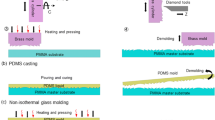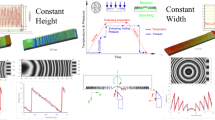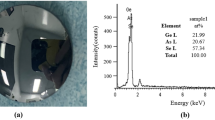Abstract
The purpose of this paper is to use micro-electroforming and hot-embossing technology as an alternative to high-cost precision cutting or traditional injection molding in the fabrication of plastic aspheric lenses with high Blu-Ray transmittance. The female dies for the aspheric lenses are fabricated from UV-cured SU-8 polymer via electrostatic attraction. However, SU-8 has a 405 nm Blu-Ray transmittance of only roughly 40–50%, which is not appropriate for use in high-density optical pickup systems. This paper, therefore, uses low stress, low surface roughness, nickel micro-electroforming and molding technologies and employs a micro hot-embossing system to form aspheric lenses with high Blu-Ray transmittance from COC plastic (transmittance: 88% at 405 nm). The resulting lenses have a clear aperture of approximately 1 mm and a numerical aperture of roughly 0.6. The electroforming mold has a roughness of approximately 8 nm as measured by AFM. The roughness of COC (n = 1.53) aspheric lenses after hot-embossing is approximately 146 nm (300 µm × 220 µm) as measured by white light interferometer (WYKO). The shape precision of the hot-embossing COC and original SU-8 (n = 1.67) aspheric lenses can be controlled with approximately 2.638% error. The spot size of the hot-embossed COC and original SU-8 aspheric lenses can be controlled with approximately 11% error. This error should account for the material refractive index difference and the shape error. The roughness and spot size were also tested using different pressing temperatures and forces. This technology could be developed to fabricate lenses in Blu-Ray 405 nm micro-optical systems.
Similar content being viewed by others
Explore related subjects
Discover the latest articles, news and stories from top researchers in related subjects.Avoid common mistakes on your manuscript.
1 Introduction
Microlenses are among the most commonly used elements in optical systems and are employed in optical storage systems, optical communications equipment and displays. In light of this situation, batch manufacturing methods must necessarily play an important role in filling demands for microlenses. The fabrication of microlenses generally involves the use of thermoplastic (Daly et al. 1990), micro-nozzle (Cox et al. 2001), gray-scale mask (Jiang et al. 2001) or molding methods (Lee et al. 2004; Moon et al. 2003; Heckele et al. 1998). Some authors have proposed using gradient electrostatic force attraction (Hung et al. 2008) to produce micro-aspheric lenses, followed by UV cure forming. However, the use of SU-8 in such applications is limited because the polymer has poor transmittance over short visible light wavelengths (405 nm). In contrast, ordinary plastics such as polymethylmethacrylate (PMMA), polycarbonate (PC), and polybutadiene–styrene (PBS) are solid at room temperature and cannot be shaped by electrostatic force and UV curing.
Therefore, in order to meet the requirement of high transmittance while effectively controlling the shape of the aspheric lens, this paper uses a cure-molded SU-8 aspheric lens as a micro-electroforming female die and further uses micro molding technology to fabricate lenses from high transmittance COC plastic (Hung et al. 2008). Molding techniques include injection molding, compression molding and hot forming. Of these, hot forming can simultaneously produce products with high quality and high precision. In addition, the short flow distance and low shear rate minimize stress within the resulting product. This method is therefore optimal for molding microstructures. When implementing hot forming, attention must be paid to factors that may affect the precision of the finished product, such as mold surface roughness, cleanliness and friction between the mold and polymer. Because the hot forming process is highly reproducible, it can be used to produce large numbers of products with low production cost. The molding material may consist of different polymer forms, such as powders, pieces, and films. In this paper, we use COC 5013 granular as the material.
2 Research methods
Figure 1 shows the transmittance of the plastic material for 405 nm light. At a thickness of 1.6 mm, COC has a transmittance of 88% (at 405 nm, the refractive index is 1.53, and T g is 135°C). Because this material has a high transmittance and low water absorption (<0.01) characteristics and the CTE is 6 × 10−5 ppm, it is therefore suitable for the Blu-Ray system. Figure 2 shows the process flowchart employed in this paper. This paper used low stress, low surface roughness nickel micro-electroforming technology. The high transmittance plastic COC was placed in a micro hot-forming system and formed as aspherical lenses with high blue light transmittance. The resulting plastic lenses had a diameter of 1.4 mm and a height of roughly 0.4 mm; the mold size was 2.5 cm × 2.5 cm. This paper employed e-beam evaporation to deposit Ti/Ni on aspherical lens dies. A 300-Å titanium layer was deposited first to serve as an adhesion layer, and a 1,500 Å nickel layer was then deposited as the electroforming initiation layer. The nickel electrolyte was nickel sulfamate. The electroforming equipment included an electroforming tank with recycle filtration, a power source, a stirring pump, a heater and temperature sensors. Table 1 shows the nickel electroforming tank operating conditions. The time of mold production can be calculated on the basis of Faraday’s law using the following formula:
where \( m_{\max } \) is the weight of precipitation (cathode) or dissolution (anode), I is the current, t is the deposition time, M is the atomic weight, F is Faraday’s constant, 96,487 C, and z is the charge number. In this paper, I is 92.5 mA, the electroforming area is 9.25 cm2, and the deposition time is 24.4 h for fabricating a nickel mold with a thickness of 300 μm.
Figure 3 shows a schematic diagram of the self-developed hot forming system. The system includes a balance for measuring the applied force, a heater for melting the plastic, a compression system and a universal joint to ensure the even application of force. COC is solid at room temperature and must therefore be heated until it is in a molten state. However, when the plastic is heated, oxygen is readily absorbed from the atmosphere and forms bubbles; thus, controlling the heating and cooling temperatures is extremely important. Figure 4 shows the relationship between the hot forming temperature and pressure in this paper. The hot forming process consisted of four main steps:
-
(1)
COC readily forms bubbles when heated. To avoid the formation of bubbles, the plastic was heated to the melting point at a rate of approximately 220°C/30–60 min and then cooled to the pressing temperature.
-
(2)
After the plastic was cooled to a temperature above the glass transition temperature, pre-pressure was applied in order to maintain the smoothness of the polymer and ensure that the material was evenly heated during further cooling.
-
(3)
After the temperature gradually fell to the hot forming temperature, there was a short time pause in order to ensure that all the material had reached the preset temperature before increasing the pressure and performing the hot forming.
-
(4)
The lenses were cooled and released from the mold after the hot forming time. Mold release successfully yielded COC aspherical microlenses.
3 Experiment results
Because of the small size of the aspherical lenses and the large profile changes near their edges, it was difficult to measure their edge profile or three-dimensional shape. As a consequence, this paper relied on imaging and curve fitting to determine the profile parameters of the lenses.
3.1 Use of lateral images to determine shape of SU-8 and COC lenses
A CCD camera was used to photograph the lenses. With a measurement precision of less than 1 µm, it can be seen, in Fig. 5, that the heights of the SU-8 and COC lenses were 356.8 µm. After the completion of the electroforming, hot forming was used to fabricate COC lenses at different pressures and temperatures. Figure 6a–d show results for a pressure of 10 kg; Fig. 6e–h show results for 20 kg; Fig. 6i–l show results for 30 kg; and Fig. 6m–p show results for 40 kg. The lens heights were approximately 356.8 µm at all pressures and temperatures.
3.2 Determination of hot-formed COC micro-aspherical lens quality
This paper used a WYKO Optical Profiler to measure the surface roughness (Ra) of the lenses. This instrument has a field-of-view of 300 µm × 220 µm and uses the principle of white light interferometry to determine the nature of the surfaces of objects. The measurement results are shown in Fig. 7. Because of the good heat resistance of COC plastics, the high mold temperature did not damage the lens surface profile or cause the surface roughness to increase. The roughness was approximately 146 nm (Fig. 7c).
3.3 SU-8 and COC lens curve fitting
Figure 8 shows curve fitting results for the SU-8 lens, mold and COC lens produced in this paper. The lateral image shown in Fig. 5 reveals that the shape of the SU-8 lens was slightly high on the left and low on the right. This is very close to the curve fitting results. Figure 9 shows the height error of the SU-8 and COC lenses for different pressing temperatures and forces. The data indicate that higher pressing temperatures and forces would reduce height errors to 2.638% (40 kgw, 185°C). Figure 10 shows the height error of the Ni female dies and COC lenses for different temperatures and forces. The data presented here indicate that higher pressing temperatures and forces would reduce height error to 1.6% (40 kgw, 185°C). Therefore, the error between the Ni model and SU-8 lens is about 1%. Figure 11 shows the spot size for different pressing temperatures and forces. The spot size of the original SU-8 aspheric lens is 0.88 µm (Fig. 12a). In this paper, a similar COC aspheric lens has a spot size of about 0.98 µm (Fig. 12b). The error of the spot size between the SU-8 and COC aspheric lenses is approximately 11%. The better measured results have the following parameters: 10, 20 kg/185°C and 30, 40 kg/155°C. The reasons for better profile could be that under high temperature the plastic fluidity is good, which is helpful for embossing the microlens. However, if the pressing force is too great, it could cause damage to the lens surface profile. Yet, if the temperature is low, a large pressing force must be used, which can cause microlens smooth. In the literature (Datta and Goettert 2007), when the system regulation temperature is high the pressing force must be reduced. The opposite is the case at low temperature. Therefore, for the system regulation parameters, the temperature and the pressing force must match to obtain the balance point and yield good experimental results. Figure 13a shows the image amplification of the COC aspheric lens and our COC aspheric lens product (Fig. 13b).
4 Conclusions
This paper successfully used low stress, low surface roughness, nickel micro-electroforming and molding technologies and employed a micro hot-embossing system to form aspheric lenses with high Blu-Ray transmittance from COC plastic (transmittance: 88% at 405 nm). The resulting lenses have a clear aperture of approximately 1.4 mm. The electroforming mold has a roughness of approximately 8 nm as measured by AFM. The roughness of the COC (n = 1.53) aspheric lenses after hot-embossing is approximately 146 nm (300 µm × 220 µm) as measured by white light interferometer (WYKO). The shape precision of the hot-embossing COC and original SU-8 (n = 1.67) aspheric lenses can be controlled with approximately 2.638% error. The spot size of the hot-embossed COC and original SU-8 aspheric lenses can be controlled with approximately 11% error. This error should account for the material’s refractive index difference and the shape error. The roughness and spot size were also tested for different pressing temperatures and forces. This technology could be developed to fabricate lenses in Blu-Ray DVD micro-optical systems.
References
Cox WR, Chen T, Hayes DJ (2001) Micro-optics fabrication by ink-jet printing. OSA Opt Photonics News 12(6):32–35
Daly D, Stevens RF, Hutley MC, Davies N (1990) The manufacture of microlens by melting photoresist. Meas Sci Technol 1:759–766
Datta P, Goettert J (2007) Method for polymer hot embossing process development. Microsyst Technol 13(3):265–270
Heckele M, Bacher W, Müller KD (1998) Hot embossing—the molding technique for plastic microstructures. Microsyst Technol 14:122–124
Hung KY, Tseng FG, Liao TH (2008) Electrostatic force modulated micro-aspherical lens for optical pickup head. J Microelectromech Syst 17(2):370–380
Jiang HG, Yuan XC, Yun ZH, Chan YC, Lam YL (2001) Fabrication of microlens in photosensitive hybrid sol–gel films using a gray scale mask. Mater Sci Eng 16:99–102
Lee BK, Kim DS, Kwon TH (2004) Replication of microlens arrays by injection molding. Microsyst Technol 10:531–535
Moon SD, Lee N, Kang S (2003) Fabrication of microlens array using micro-compression molding with an electroformed mold insert. J Micromech Microeng 13:98–103
Author information
Authors and Affiliations
Corresponding author
Rights and permissions
About this article
Cite this article
Hung, KY., Chen, YK., Huang, SH. et al. Molding and hot forming techniques for fabricating plastic aspheric lenses with high blue-light transmittance. Microsyst Technol 16, 1439–1444 (2010). https://doi.org/10.1007/s00542-009-0936-9
Received:
Accepted:
Published:
Issue Date:
DOI: https://doi.org/10.1007/s00542-009-0936-9

















